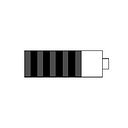Some Thoughts on The Tesla Power Wall
I think about big, cheap batteries for a living, so I stayed up late and listened to the Tesla announcement. My first thoughts below. TL;DR: fantastic prices for a UPS, still expensive as day to day electricity. The 7kWhr battery may be something very special in the expected cycled life.
In terms of what you get compared to market prices on what this is, this is a good deal. $350/kWhr for a 10 year battery. Doesn’t include inverter but it’s everything required (cells+pack out+power electronics) to the inverter. In 2015 this is a lot of battery for the money. Slam dunk as a UPS. All numbers below assume an electrician owes you a favor and an inverter.
Digging into the detail highlights challenges the system will face against fossil fuels, and this isn’t Tesla doing anything wrong, this is the challenge of the current state of the art technology. Weekly cycles at a spec’d discharge rate of a 5 hour basis (2kW for 5 hours). 10 years of weekly cycles is a real number , just over 500 cycles at an 80% DoD. The problem is the cost structure hurts here, if the battery is used to its spec’d amount it works to $0.66/kWhr-cycle, or over 5 times the market rate for electricity in NJ, and this doesn’t account for the generation that has to go into the battery. Even with heavily subsidized solar that’s a combined $0.70 /kWhr-cycle. Using the battery less makes it cost more based on its intended metrics: it’s just an unfortunate coupling of batteries.
This is the best case scenario near maximum utilization, if you use the battery less over 10 years you pay more per cycle (analogous to buying more land or insurance than you need). If you buy the battery that’s a sunk cost as well, so with the time value of money it’s more like $0.70 to $0.75/kwhr-cycle. There is an extended warranty, pricing details on that are unclear but my guess is that it’d be hard for Tesla to make any money if the number dropped to below $0.50/kwHr-cycle. I’m making things up now so I’ll stop beating this point.
On a per kW basis installed it’s roughy 10x the cost of a standard generator system, not accounting for the price of gas. Assuming gas is ~$0.03 to $0.05/kWhr and the genset is 20% efficient, the cost of energy is 4x to 8x depending on hours of use.
On paper lead acid should be able to do this as a lower cost per cell, but I think the required installation mass alone would offset the install cost. Also anyone that tries to realize this tends to go bankrupt.
In rough numbers: at this cost you either need 10x the cycle life to compete with a genset at full utilization. In order to compete with utility pricing of electricity you need 10x the cycle life at 1/3rd the cost.
Playing armchair investor: They probably did this to hedge against people not buying enough cars to saturate Gigafactory supply in the short term. Despite my notes above about the challenges $3500+inverter to be a part of the Tesla brand speaks to my id if not my ego.
Overall, if Tesla can deliver on what they claim here, it’s an important line in the sand for this market, and it can only force prices down. Until now Sony and Panasonic have been selling similar systems for 3x the price, with little market uptake.
It’s 2 AM: Everything above is subject to revision.
UPDATE: last night I overlooked the 7 kWhr battery @ $3000. If you are getting this out of the battery every day for 10 years the price drops to $0.12/kWhr-cycle, again neglecting installation and inverter. If this is truly the spec this is an exceptional number. It is still more expensive than a genset because the genset can run @ $200/kW, and this is $1500/kW. Also, remember that this is the cost after you already pay for the energy to charge it. All in, based in NJ, this is still 2x the cost of grid delivered energy at best.
Still, I am curious what the specific use case is for the 7 kWhr battery, and if Tesla expects over 3000 cycles. If so, this pack is the star of the evening.

